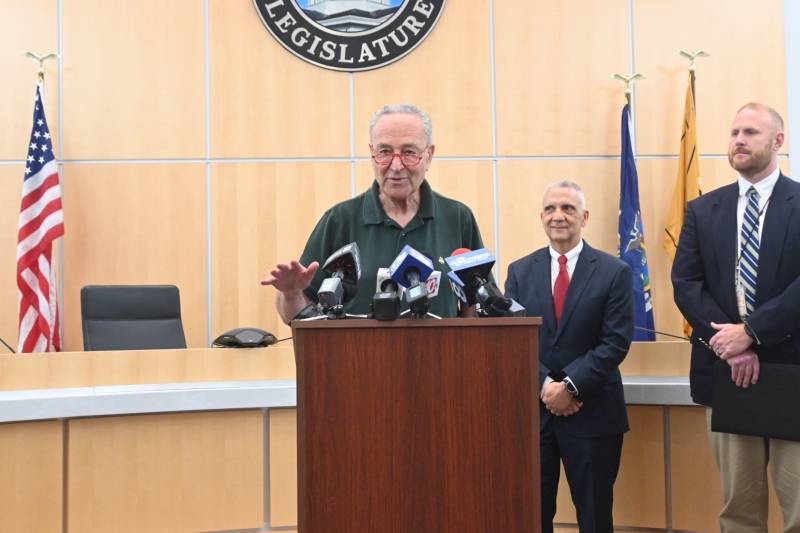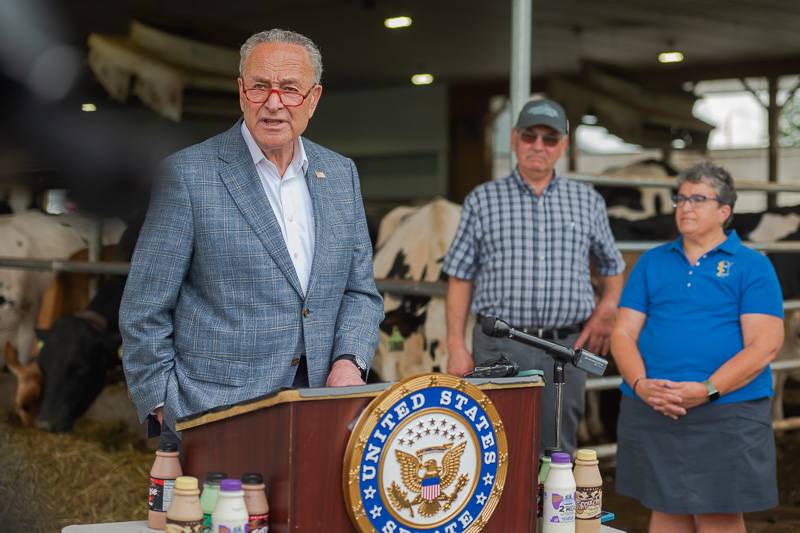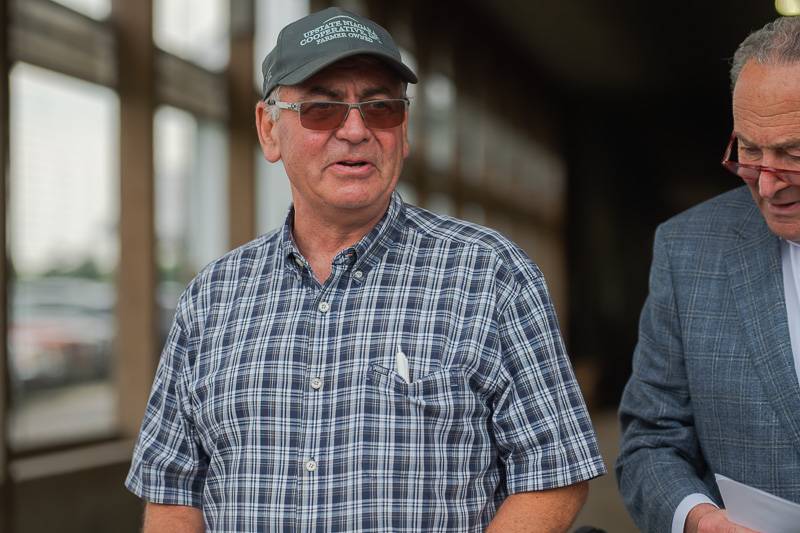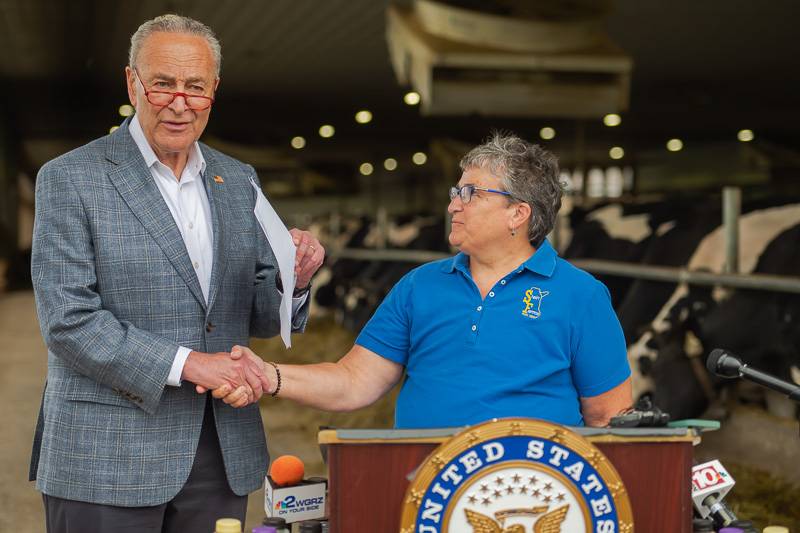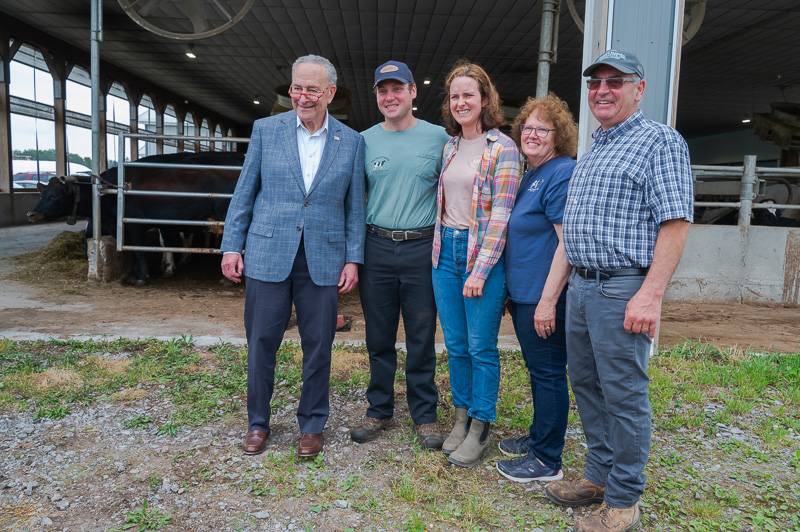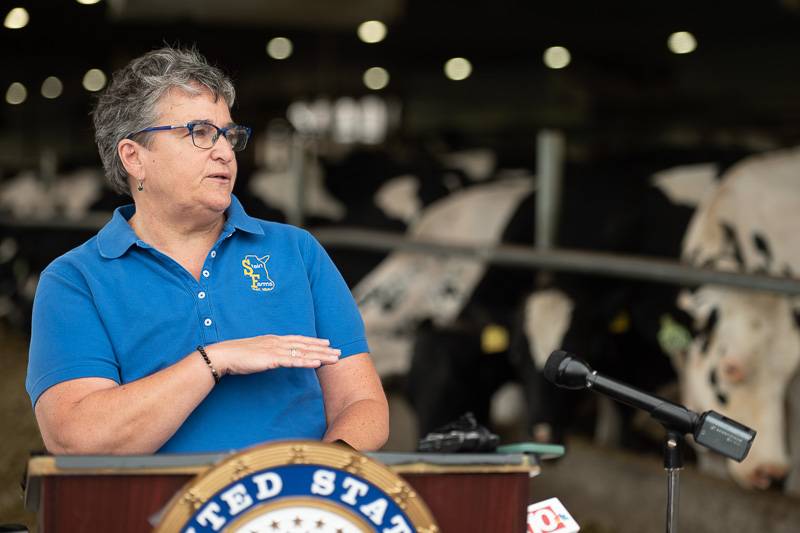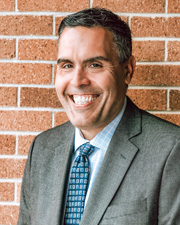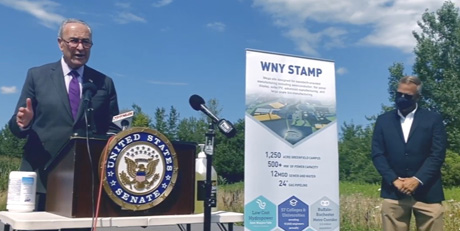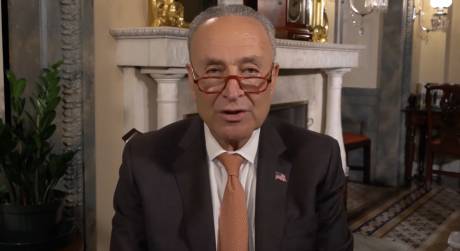Schumer added, “At the close of twenty-three years, my beliefs are as clear as ever: ‘Senators who stay in Washington and never return home are simply not doing their job.’ That’s why I bike the streets and go to all of the parades, graduations, and occasionally crash a neighbor’s block party for a plate. Whether I’m at the State Fair in Syracuse or wearing my ‘Ithaca is Gorges’ mask, New York is always on my mind and I’m always learning more about New York directly from my constituents.”
Some of the key highlights include:
NEW YORK STATE
Delivered BIG For New York With $100 Billion For New York In COVID Relief Through The American Rescue Plan and $27+Billion Through the Bipartisan Infrastructure Investment & Jobs Act. As Majority Leader, and the chief negotiator in the Senate, Schumer worked nonstop to deliver a plan that best provided robust relief to New York’s local leaders, workers, small businesses, and health centers so they could recover from the impacts of COVID and build back stronger than before.
Senator Schumer delivered substantial relief for New York over the past year:
· Over $23.8 Billion In Fiscal Relief For NY’s State and Local Governments:
Delivering on his promise of robust relief for New York State, as part of the American Rescue Plan, Senator Schumer ensured New York State, New York City, and every municipal government from counties to towns to the smallest villages, could pay for essential services, retain vital frontline workers, offset lost revenues and increased costs from the COVID-19 emergency, and rebuild local economies.
· Nearly $4.2 billion More for New York’s Medicaid Program:
Senator Schumer’s hard-won provision in the Families First Coronavirus Response Act continued to deliver an estimated $4.2 billion to New York’s Medicaid program throughout 2021. These funds have helped the state continue to provide high quality health care at low costs to ~6.8 million low-income New Yorkers.
· Over $1.26 Billion More for Home-and-Community Based Services:
Senator Schumer included one year of enhanced federal funding for home- and community-based health care services that has delivered over $1.26 billion in direct funding to New York. This money has gone to support seniors and people with disabilities receive the care they need at home or in their community if they so choose by expanding the availability of services and increasing the types of services offered across the state.
· Over $13.5 Billion NYS Hospitals, Health Systems, Community Health Centers and Other Providers:
Following his leadership in creating the Provider Relief Fund, Senator Schumer has fought to deliver over $13.5 billion to New York health care providers through the COVID-19 pandemic with billions more on the way before the end of 2021. This money has assisted local hospitals, health centers, physician offices and more test, diagnose and treat patients with COVID-19 and mitigated the massive financial losses incurred by our health system drive by pandemic-related costs and lost revenues.
· Over $330 Million to Support NYS’s COVID-19 Testing Infrastructure:
Senator Schumer fought for and secured over $1.1 billion through the Consolidated Appropriations Act, 2021 and another $330 billion through the American Rescue Plan to expand and enhance New York’s COVID-19 testing and tracing infrastructure. This critical component of our national response to the pandemic has helped curb the spread of the coronavirus in New York and saving lives.
· $175 Million For COVID-19 Vaccines For New Yorkers:
As part of the Consolidated Appropriations Act, 2021, Senator Schumer delivered over $175 million in direct funding to New York State and New York State that has resulted in over 80% of eligible New Yorkers receiving at least one vaccine shot including 69% who are fully vaccinated.
· $170 Million in Substance Abuse and Mental Health
· Delivered $22 Billion In Direct Stimulus Payments To New Yorkers:
Senator Schumer pushed hard to include an additional round of Economic Impact Payments of $1,400 in the American Rescue Plan, including eligible payments for children amounting to $5,600 for an average family of four. Because of Schumer’s efforts, nearly 9 million New York households received direct stimulus payments, to help them to cover essential expenses like food, rent or mortgages, medical bills, and help spur economic activity in their communities.
· Secured estimated $18.4 Billion for New York Transit:
As commuters and riders stayed at home during the pandemic, transit ridership fell while agencies needed to keep service running for essential workers and those who depend on transit. Increased cleaning frequencies and reduced ridership led to higher operating costs. Senator Schumer secured $7.3 billion for New York transit systems in the ARP to help agencies bridge the gap. He then secured an estimated $11.1 billion for New York transit agencies over five years, a significant increase over the previous transportation law, so that transit can continue to build back better as it recovers from the pandemic.
· More Than $1.3 Billion For New York Airports:
The travel industry was among one of the hardest hit by the pandemic, Senator Schumer fought to include over $418 million in the ARP to provide New York’s hard-hit airports the relief they desperately needed. Then, building on his advocacy Schumer followed this relief by securing an additional investment of over $937 million through the IIJA to airports to help NY’s airport take off and reach new heights.
· Secured $11.5 billion in Highway Funding for New York over the Next 5 years:
This includes $289 million for Transportation Alternatives walking and biking funding and an estimated $1.9 billion in formula funding for a new bridge replacement program. In his commitment to addressing climate change, Schumer secured $175 million for a new National Electric Vehicle formula program and $239 million for the PROTECT formula program to build and rebuild transportation assets with resiliency in mind.
· Over $9 Billion In COVID Relief For New York K-12 Schools:
Senator Schumer made it a top priority to give our schools the robust and flexible funds they needed to reopen safely for in-person instruction and addressing the diverse needs of students due to the pandemic.
· $2.6 Billion For NY Colleges, Universities, And Student To Recover From Pandemic:
Higher Education Institutions were on the frontlines of preventing the spread of COVID-19 and ripped massive holes in their budgets to keep students and communities safe. Senator Schumer ensured not only to include relief to account for reopening costs, revenue losses, classroom retrofits, PPE, and other expenses, but also that half of any colleges federal allocation went directly to students to address hardships caused by COVID-19.
· $428 Million For NY’s Drinking Water and Clean Water State Revolving Funds:
A long time clean water advocate, Senator Schumer worked hard to bolster this funding for NY in the IIJA. Schumer said this massive boon for New York’s water infrastructure and environment, would accelerate New York’s ongoing efforts to remove lead pipe and cleaning up emerging contaminates – like PFAs.
· Over $7 Billion In Historic Child Tax Credit (CTC) For NY Families:
Almost 90% of all New York families benefited from Senator Schumer’s tireless fight to expand the Child Tax Credit, allowing 86% of families across the state to get $300 automatic payments each month.
· More than $54 billion in COVID relief to support New York’s small businesses and nonprofits:
Schumer delivered over $54 billion in federal forgivable loans through the Small Business Administration’s Paycheck Protection Program and grants and low-interest loans through Economic Injury Disaster Loan program, supporting hundreds of thousands of New York’s small businesses and nonprofits. Schumer fought to include nonprofits in these programs, including religious organizations and large nonprofits that provide critical services to communities through the state.
· More than $500 million from the American Rescue Plan’s State Small Business Credit Initiative:
These funds will help expand access to credit and investment for small businesses and start-ups, including minority-owned and other disadvantaged businesses, across the state to grow, create jobs, and strengthen Main Streets.
· Over $3.6 billion in relief delivered to more than 9,700 New York restaurants:
Schumer fought to include an initial infusion of funds in the American Rescue Plan to stand-up a dedicated relief program to provide flexible grants to support the state’s hard-hit restaurant industry.
· More than $1.9 billion was awarded to New York through the Shuttered Venue Operators Grant, otherwise known as the ‘Save Our Stages’ program:
Schumer led the effort to pass this critical lifeline for the cultural arts industry into law. This funding was awarded to more than 1,400 theaters, independent music venues and comedy clubs, independent movie theaters, and cultural institutions like museums and zoos across the state, bringing Broadway back and helping New York’s cultural treasures in every corner of the state keep the light and laughs on.
· Over $44.9 million from the Economic Development Administration (EDA) from the American Rescue Plan directly awarded to New York:
Schumer prioritized dedicated relief to revive New Yok’s tourism and travel industry in the American Rescue Plan. These EDA funds support marketing, infrastructure, workforce, and other projects to rebuild New York’s travel, tourism, and outdoor recreation economy, so New York is ready to welcome the world back to the state as we emerge from the worst of the pandemic.
Over $130 million For New Yorkers Who Lost A Loved One To COVID In FEMA Funeral and Cemetery Expenses Reimbursement:
After tireless advocacy, starting in the very early days of COVID, Senator Schumer secured access to a rarely used FEMA program that reimburses individuals who lost a loved one to COVID and helped cover the funeral and cemetery costs. With the loved ones of over 19,000 New Yorkers lost to COVID already reimbursed, and about $1.5 billion provided across the country, this program has helped New Yorkers across the state in their darkest hour. This assistance is available for anyone who lost a loved one to COVID and had to bear this unexpected expense, you can find out more by calling: 844-684-6333
Almost half-a-billion dollars to help New Yorkers recover and rebuild three months after Hurricane Ida struck New York:
When Hurricane Ida hit New York in September, it left thousands of New Yorkers reeling. Now, three months later, close to 36,000 New Yorkers from the Bronx, Brooklyn, Queens, Staten Island, Dutchess, Nassau, Orange, Rockland, Suffolk, and Westchester counties have been approve for FEMA’s individual assistance program. Combined with funding provided through the US Small Business Administration and the National Flood Insurance Program, these federal lifelines have provide almost half-a-billion dollars to help rebuild, and rebuild stronger. Applications are still open, currently until January 4, 2022, and you can apply if you were impacted by Hurricane Ida at DisasterAssistance.gov
WESTERN NEW YORK
Senator Schumer delivered substantial relief for Western NY over the past year:
· Over $873 million in aid to Buffalo and Western NY local governments
· Over 550 Western NY restaurants received over $109 million through the Restaurant Revitalization Fund
· Over $42 million for Shuttered Venue in Western NY like Shea’s Performing Arts Center and the National Comedy Center
· $204 million for Higher Education institutions like the University at Buffalo, Niagara University, and more
· Airports in Western NY received over $68.9 million
· Throughout the pandemic, 33,000 businesses in the Western NY region have received over $3.34 billion in PPP funds
Dramatically Expanded The Child Tax Credit And Instituted Monthly Payments For 85% of Western New York Families Which Amounted To $77 Million:
As part of the Child Tax Credit (CTC) expansion, Senator Schumer was able to secure an increased in the number of eligible families and authorized monthly disbursements of the Child Tax Credits. With 85% of Western New York families eligible for this groundbreaking program, Schumer noted that it was especially significant in the City of Buffalo, which has one of the nation’s highest poverty rates and as many as 25,000 children living in poverty. As many as 107,000 households in the Greater Buffalo-Niagara region.
Finally Orchestrated The Implementation Of The Pilot Record Database Following The Advocacy Of The 3407 Families:
In December, the Pilot Record Database being kept by the FAA finally went live, enabling airlines to have a thorough record of the training history and service record of each current and prospective pilot. This database, a longtime Schumer priority, was first proposed following the successful advocacy of the families of the victims of Flight 3407. While the database was supposed to be created years ago, bureaucratic red tape and administrative inaction led to the database languishing in development. Schumer was able to cut through the red tape and convinced DOT officials to finally get the program up and running.
Recommended The Nomination Of Trini Ross To Be The First African American Woman For US Attorney In Buffalo:
Schumer recommended Trini Ross to President Biden for nomination as United States Attorney for the Western District of New York. Ms. Ross is a lifelong Buffalonian, a graduate of Hutchinson Technical High School, SUNY Fredonia, and UB Law. She is an experienced prosecutor and was unanimously confirmed by the Senate. Ms. Ross is also the first African American woman to serve as the WDNY’s top federal prosecutor. She assumed her position in November of this year.
Secured $1 Billion - The Largest Single Allocation In The History Of The Great Lakes Restoration Initiative:
Senator Schumer was able to include a $1 Billion allocation to fully fund the Great Lakes Restoration Initiative (GLRI) in the bipartisan infrastructure deal. Specifically, this funding was secured to protect, improve, and preserve the Great Lakes and their related waterways, which include the Niagara River, Buffalo Creek, and many other areas along the Western New York shoreline. This funding is utilized by 16 different agencies and often works through local organizations like Buffalo Niagara Waterkeeper. Schumer also noted the economic impact of the Great Lakes, adding that for every dollar invested in Great Lakes protection, the return on investment is $3.35, or 335%.
Saw To It That Western New York Students Were Fairly Compensated For AP Exams Which Went Missing:
After taking their Advanced Placement exams, some students at Startpoint High School in Lockport were informed that UPS had lost the box of exams on their way to be scored by College Board. Schumer intervened with both College Board and UPS and ensured that the tests were found and the students were fairly compensated and were also awarded $250 scholarships.
Bolstered Western New York’s Transportation Infrastructure By Securing the Largest Ever Federal Investment In Upstate Transit Agencies, Including $156.5 Million for NFTA:
Aware of the need to major investment in Western New York’s transit agency, Schumer was able to secure $156.5 Million in federal monies for the Niagara Frontier Transportation Authority (NFTA) over FY22-26. This was part of a larger federal infrastructure investment that saw almost $90 Billion go to transportation agencies as part of Schumer’s plan to finally bring public transportation into the 21st century. These funds can be used for everything from the continuation of daily operations, to maintenance and bus procurement.
LONG ISLAND
Senator Schumer delivered substantial relief for Long Island over the past year:
· Over 1 Billion in aid to County, Town, and village governments
· Approximately 1,100 restaurants received over $270 million through the Restaurant Revitalization Fund
· Over $57 million to over 100 Shuttered entertainment venues, organizations, and companies
· Over $323 million to Long Island’s public school districts
· Over $266 million to higher education intuitions on Long Island
· Airports on Long Island received over $39 million
· Throughout the pandemic, 121,041 businesses on Long Island have received over $10.50 billion in PPP funds
Delivered Record $106 Million Investment to Protect Long Island Sound:
Schumer successfully fought to deliver $106 Million for the Environmental Protection Agency’s (EPA) Long Island Sound Program. More than 23 million people live within 50 miles of the Long Island Sound, an important natural resource that is home to more than 120 species of fish and is an economic engine that draws families, boaters, tourists, and anglers to Long Island. This record investment will be delivered over the next five years to continue efforts to rehabilitate and preserve the Sound for generations to come, and is in addition to the annual appropriations Senator Schumer fights for each year.
Secured Timely Federal Approval of $232 Million Disaster Aid for Construction of the Critical Suffolk County Coastal Resiliency Initiative:
Schumer advocated to the Federal Emergency Management Administration (FEMA) and Office of Management and Budget (OMB) for approval of $232 million in post-Sandy disaster aid he secured to be used for the Suffolk County Coastal Resiliency Initiative, paving the way for construction of this critical infrastructure project and ensuring that construction begins on schedule. These federal funds – paired with $46 million that Senator Schumer secured for Suffolk County via the American Rescue plan – are being used for the largest sewer expansion program in Suffolk County in approximately 40 years.
Reeled-In Victories and Disaster Assistance for Long Island’s Fishing and Shellfishing Industries:
In May, Schumer called on Commerce Secretary Gina Raimondo to keep a New Yorker in one of the Mid-Atlantic Fishery Management Council’s at-large seats. The retention of this seat and the representation it provides New York on the Council is essential to providing fairer fishing allocations and correcting past injustices that have burdened New York’s fishermen and hampered one of Long Island’s legacy industries. In June, Long Islander Tom Schlichter was appointed to the seat. Also in June, after Schumer’s advocacy following a widespread scallop die-off in Peconic Bay in 2019 and 2020, Secretary Raimondo announced a disaster declaration for the Peconic Bay scallop fishery. This declaration makes the fishery eligible for disaster assistance from the National Oceanic and Atmospheric Administration (NOAA) and may also unlock assistance from the Small Business Administration (SBA). In July, Schumer wrote to the Atlantic States Marine Fisheries Commission (ASMFC) advocating for an increase in New York’s black sea bass commercial quota allocation after New York State appealed the initial allocation decision, noting that New York’s portion of the commercial quote had not been updated to reflect the increased abundance of black sea bass in New York’s waters. In August, the ASMFC’s Summer Flounder, Scup and Black Sea Bass Management Board approved an allocation increase, increasing the amount of fish New York’s fishermen can catch.
Secured $1 Billion Cybersecurity Grant Program For Federal Cybersecurity Assistance To State And Local Governments, Including Schools:
In the Bipartisan Infrastructure and Jobs bill Schumer secured crucial cybersecurity assistance for state and local government to modernize their cybersecurity infrastructure and give state and local entities the tools they need to stop malicious hacks. The $1 billion grant also targets rural communities that may have less access to cybersecurity assistance and resources. After numerous recent cyberattacks on local governments in New York, school systems, and a water treatment facility Schumer announced at the Manhasset Secondary School the $1 billion authorization and encouraged local leaders, school administrators, and county officials to begin working with the NY state government to prepare a cyber-resource plan to secure federal assistance from the $1 billion grant program to prevent and mitigate future attacks.
CAPITAL REGION
Senator Schumer delivered substantial relief for the Capital Region over the past year:
· Over $549.5 million in aid to local governments
· Over $39 million for Shuttered Venues in the Capital Region
· $152 million for Higher Education institutions like the University of Albany, Rensselaer Polytechnic Institute, and Adirondack Community College.
· $52.5 million for Capital Region transit systems like the Capital District Transit Authority (CDTA), and the Greater Glens Falls Transit.
· Airports in the Capital Region received $49 million
· Throughout the pandemic, 30,238 businesses in the Capital Region have received over $2.7 billion in PPP funds
Following passage of USICA, GlobalFoundries Commits to Building Fab 8.2 and Relocating Headquarters to Malta:
In April, Schumer visited GlobalFoundries to announce that the company has decided to move its headquarters from California to Saratoga County. In June, the Senate, under Schumer’s leadership passed the United States Innovation and Competition Act (USICA) which will invest $52 billion into the domestic semiconductor industry by implementing the federal semiconductor incentive programs Schumer passed into law as part of last year’s National Defense Authorization Act. Two months later Schumer returned to Malta, this time with US Department of Commerce Secretary Gina Raimondo, to announce that GlobalFoundries has decided to build a second semiconductor fabrication plant at the Luther Forest site. This project, which will look to make use of the billions of dollars in federal incentives Schumer is working to finalize, will get underway in 2022 and will create thousands of union construction jobs and over one thousand permanent jobs at the new fab.
Established Federal Limousine Safety Regulations in Response to the Tragic 2018 Limo Accident in Schoharie:
After the terrible limousine crash in Schoharie, NY that killed 20 people, Schumer promised the victim’s families that he would not rest until the federal government established limousine safety regulations aimed at preventing future tragic incidents. This August, Schumer worked in a bipartisan way, on the floor of the Senate to overcome an objection to the inclusion of these standards into the Infrastructure Investment and Jobs Act. When President Biden signed the measure into law on November 15, Schumer saw to it that Kevin Cushing, who became a tireless advocate for limo safety after his son Patrick was killed in the Schoharie incident, was in attendance at the White House ceremony. The law addresses limo safety with a ten point plan that includes funding, new inspection rules, vehicle crash testing, and new standards regarding seat belts, seating systems, retrofit assessment for existing limos and safety standards for altering used vehicles into limousines.
Delivered $61 Million for CDTA to Establish the “Purple Line” Bus Rapid Transit Route:
Last year, CDTA began service on its popular “Blue Line” bus rapid transit route which connects Albany with Watervliet, Cohoes, Troy and Waterford, which was made possible by federal funding from the Federal Transit Authority’s Small Starts program. Senator Schumer has worked with CDTA for the last decade on this effort, first to gain CDTA’s inclusion into the program, and then to maximize the level of funding. This summer, FTA announced that it has made $61 million from the program available to CDTA for the establishment of the next bus rapid transit route. The “Purple Line”, first envisioned by CDTA and Schumer when he visited the College of St. Rose on October 21, 2013, will connect downtown Albany, with St. Rose, the Harriman Campus, the University at Albany and Crossgates Mall. Together with the “Red Line” service that connects downtown Albany with downtown Schenectady along Central Avenue, CDTA’s growing network of bus rapid transit routes have transformed public transportation in the Capital Region and established a model for transit systems across upstate.
ROCHESTER-FINGER LAKES
Senator Schumer delivered substantial relief for the Finger Lakes region over the past year:
· Over $566.09 million in aid to Rochester and Finger Lakes local governments
· 412 Finger Lakes restaurants received over $77.72 million through the Restaurant Revitalization Fund
· Over $28 million for Shuttered Venue in the Finger Lakes
· $163.84 million for Higher Education institutions like the University of Rochester, RIT, and more.
· Rochester-Genesee Regional Transportation Authority received over $139.98 million between the American Rescue Plan and the Bipartisan Infrastructure bill to support their 900+ employees
· Airports in the Finger Lakes received over $44.74 million
· Throughout the pandemic, 31,116 businesses in the Finger Lakes region have received over $2.89 billion in PPP funds
Successfully Landed New $125 Million Plug Power Gigafactory Bringing 377 Jobs To Monroe County:
Senator Schumer made a personal call to Plug Power CEO Andy Marsh advocating for Plug Power to choose Upstate NY for the site of its new factory. Plug Power heeded his call and officially opened its new $125 Million Hydrogen Fuel Cell Innovation Center In Monroe County this November.
Delivered Over $18 Million In Federal Funds To Start Critical Broadband Project To Bring High-Speed Internet To Livingston And Orleans Counties:
After months of advocacy, Senator Schumer secured an $11.3 million Rural Development Broadband ReConnect grant for Livingston County to bring high speed broadband internet to thousands of homes, business, and farms. In addition, t hanks to funding State and Local aide that Senator Schumer secured in the American Rescue Plan, Orleans County was able to fulfill a decades-long dream to provide high-speed internet access to the entire county by investing $7.83 million they received to provide broadband access to over 1,500 unserved households.
Secured VA Approval For The Expansion of the WNY National Veteran Cemetery:
After the Veterans Administration stripped features for the WNY National Veteran Cemetery from their 2019 plans, Schumer pushed the department to build the complete cemetery needed for local veterans and helped secure an additional $10 million to ensure the project’s completion. Thanks to his initial advocacy, construction will continue and the next phase will include an above-ground columbarium, ossuary, memorial wall, second committal shelter, a loop roadway, and landscaping to provide Upstate veterans the honorable facilities they deserve.
CENTRAL NEW YORK
Senator Schumer delivered substantial relief for Central New York over the past year:
· Over $483 million in aid to local governments
· Over $411 million for CNY K-12 school districts
· Over $172 million for CNY higher education institutions
· Over $45 million for CNY airports
· Over $112 million for Centro to support its 600 employees who operate the transportation authority's bus service in Syracuse, Oswego, Auburn, Rome and Utica
· Over $14 million for CNY community health centers
· Over $2 million for CNY Head Start programs
· Over $17 million for Onondaga County & over $7 million for Oneida County in rental & homelessness prevention funding
· Over $15 million for CNY live event venues through the Save Our Stages grant program
· Throughout the pandemic, 10,572 businesses in Central New York have received over $564.86 million in PPP funds
After Decades-Long Effort, Helped Syracuse Airport Finally Land Southwest Airlines:
For over 20 years, Senator Schumer fought to bring low-cost Southwest flights to Upstate New York to help boost competition and lower fares – but Syracuse remained the only major Upstate city without service from the airline. As local officials continued to engage with Southwest Airlines, Schumer spoke directly with the company’s CEO Greg Kelly to advocate for flights out of Syracuse and worked in congress to keep airlines solvent through the pandemic. As the economy reopened, Southwest finally launched service at Hancock International Airport in June.
Secured Funding for Saab to Expand & Create 50 Jobs In Central New York:
With an eye towards Saab’s radar technology developed in East Syracuse, Schumer secured $7 million for the Navy to advance critical improvements to its combat fleet and then ensured Saab was selected for the contract to do the important work. The new contract will create 50 good-paying jobs in Central New York, with potential for more jobs in future.
Solidified Rome Lab’s Position at the Epicenter of Quantum Computing Jobs & Innovation:
After securing tens of millions of dollars Rome Lab’s Quantum Information Science (QIS) research and development in recent years, Senator Schumer helped convince the military to establish Rome Lab as the Quantum Information Science Research Center for the Department of Defense. This landmark designation will deliver millions of additional dollars to Rome Lab, attract the nation’s top talent, and create good paying jobs in the Mohawk Valley. With the race to innovation in quantum computing proving to be the great scientific race of the 21st century, Rome Lab will ensure the U.S does not fall behind international competitors like China and Russia.
Secured Funding to Bring High-Speed Internet to 1K Homes & Businesses in Madison County:
With large parts of rural Madison County lacking access to high-speed internet, Senator Schumer worked hand-in-hand with Madison County officials as they sought funding to close the digital divide from the United States Department of Agriculture’s (USDA) Rural Development Broadband ReConnect Program. After Schumer held a personal meeting with USDA Secretary Tom Vilsak, Madison County was awarded a $10 million grant to bring new high-speed internet broadband access to over 1,000 homes, businesses and farms across the county.
HUDSON VALLEY
Senator Schumer delivered substantial relief for the Hudson Valley over the past year:
· Over $910.6 million in aid to local governments
· Over 715 Hudson Valley restaurants received over $157 million through the Restaurant Revitalization Fund
· Over $67 million for Shuttered Venue in the Hudson Valley
· $219.69 million for Higher Education institutions like the SUNY Orange, Westchester Community College, SUNY New Paltz, and more.
· Hudson Valley Transit Systems received over $12.9 billion between the American Rescue Plan and the Bipartisan Infrastructure bill
· Airports in the Hudson Valley received over $51 million
· Throughout the pandemic, 82,074 businesses in the Hudson Valley region have received over $6.49 billion in PPP funds
Secured $11.96 million to revitalize downtown New Rochelle by reconnecting Lincoln Avenue communities divided by Memorial Highway:
New Rochelle's Lincoln Avenue communities were separated from the services and support of the city's downtown in 1958 when the construction of Memorial Highway bulldozed their neighborhood. For over 3 years, Senator Schumer pushed the U.S. Department of Transportation to approve the LINC project. At the beginning of President Biden’s administration, Schumer spoke to Secretary Buttigeg directly to advocate for these funds. In November of this year, Schumer announced $11.96 million for the LINC project, which will reconnect the 25,000 residents living in the Lincoln Avenue communities to the services, transportation, and job opportunities in New Rochelle's downtown by adding walkable, bike-able city street with open green space.
Successfully secured selection in a game-changing federally funded program that increases community involvement and fast tracks the PFAS cleanup process at Stewart Air National Guard Base for Orange County residents:
Following over 5 years of fighting for clean drinking water in the City of Newburgh and its surrounding communities, Schumer announced this May that Stewart Airport will be the first Air National Guard Remedial Investigation funded under the Defense Environmental Restoration Program (DERP). This program, officially awarded to Stewart this September, provides the funds needed to begin the remedial investigation at Stewart and also allows regulators to expedite the review of documents and give the Resident Advisory Board to access funding to cover administrative costs to better educate Orange County communities about ongoing remediation efforts.
Delivered a historic $35 million federal investment to build New York's first-of-its-kind Children’s Specialty Hospital creating 400 new healthcare jobs in Sullivan County:
This $35 million investment, funded through the U.S. Department of Agriculture (USDA) Office of Rural Development’s Community Facilities Program, was needed for The Center for Discovery (TCFD) to build New York’s first short-term inpatient assessment program for children with complex conditions to begin construction, creating over 400 healthcare jobs and 150 construction jobs in Sullivan County while improving access to quality care and services for Upstate New York’s most vulnerable. In early 2020, USDA officials visited the site at Schumer's request. After the visit, COVID cases surged in Sullivan County creating unprecedented burdens for TCFD, including $5 million in lost revenue. This made the $35 million USDA investment secured by Schumer critical to keep the Children's Specialty Hospital project on track for the groundbreaking this July.
Secured hundreds of thousands for EPA to cleanup and revitalize the asbestos-contaminated former TechCity site to bring Ulster County's former economic engine back to life:
Schumer delivered hundreds of thousands of dollars for EPA to help clean up the former TechCity site, on top of historic funding for both Ulster County and the Town of Ulster through the American Rescue Plan for economic and workforce development opportunities, and billions in the Bipartisan Infrastructure Investment & Jobs Act to supercharge cleanup efforts at superfund sites like this across New York. Following Schumer's efforts and July visit, multiple community partners came together, announcing last week that the blighted former IBM site will become iPark87, creating up to 1,000 new local jobs and garnering hundreds of millions in private investment.
Secured $4 million for Access: Supports for Living to continue its life saving mental health and substance abuse services across the Hudson Valley:
Senator Schumer played a critical role in the inception of the Access Mental Health and Substance Use Urgent Care, securing $4 million and in May of 2020, he learned that Access needed additional federal support to keep its Mental Health and Substance Use Urgent Care going in the years to come. Taking action, Senator Schumer successfully secured a meeting between Access and SAMHSA to keep the Urgent Care open as demand for these services drastically increased during the pandemic. Following his tireless advocacy, Schumer announced this February that he successfully secured $4 million so Access could continue its virtual and in-person operations in Newburgh and Middletown over the next several years. For these efforts, he was also honored with the nonprofit's prestigious 'Vision of Hope' award this year.
SOUTHERN TIER
Senator Schumer delivered substantial relief for the Southern Tier over the past year:
· Nearly $330 million in aid to Southern Tier local governments
· Over 180 Southern Tier restaurants received over $40 million through the Restaurant Revitalization Fund
· Over $23.6 million for over 40 Shuttered Venue in the Southern Tier like Cinempolis and the State Theater in Ithaca, the Corning Museum of Glass, the Roberson Museum and Science Center in Binghamton, Clemens Center in Elmira, and many more
· $161 million for Higher Education institutions like Binghamton University, Ithaca College, SUNY Alfred, and more.
· $67.11 million for Transit Systems in the Southern Tier Like BC Transit in Broome County, TCAT in Tompkins County, and C-TRAN in Chemung County
· Airports in the Southern Tier received over $32 million
Secured $3.4 Million In Economic Development Administration Funding For The Hornell IDA To Support Major 250 Job Expansion At Alstom:
Following Alston being awarded a nearly $1.8 billion contract to make passenger rail cars for the Chicago Metra Commuter Rail System, Senator Schumer called Secretary of Commerce Gina Raimondo directly to advocate for the City of Hornell which needed federal funding to support critical infrastructure upgrades to the Shawmut Industrial Park to support Alstom’s massive expansion in the region. This funding directly supported the creation of nearly 250 new jobs and help cements Hornell’s position as one of the nation’s main hubs for train manufacturing.
Delivered BIG For Broome County Transportation With Over $3.2 Million Grant To Purchase Six New Electric, Zero Emission Buses And $1 Million Grant To Make Critical Improvements To The Greater Binghamton Airport:
On top of the nearly $30 million Senator Schumer secured for BC Transit and over $6.3 million for the Greater Binghamton Airport through the ARP and IIJA. Senator Schumer wrote to Transportation Secretary Buttigieg and successfully delivered on two key grants for Broome County. The first a $1 million grant through the Small Community Air Service Development Program for improvements to airport and to bolster efforts to expand air service. The second is a $3.2 million grant through the Low and No Emission Vehicle Grant Program which will allow Broome County to replace polluting diesel buses with six-battery electric, zero emission buses. In addition, the new buses will have components made by BAE Systems in Endicott, supporting local jobs while making the community cleaner.
Procured $1.4 Million Through DOL And Appalachian Regional Commission For SUNY Alfred To Support Training For 200 New Southern Tier Manufacturing Jobs:
With major regional employers in the western Southern Tier seeking to expand operations, Senator Schumer pushed for SUNY Alfred to receive funding through the U.S. Department of Labor in partnership with the Appalachian Regional Commission to develop training initiatives for specialized jobs such as welding. This funding will now support nearly 200 new skilled manufacturing jobs in the region at Alstom and Ljungström.
NORTH COUNTRY
Senator Schumer delivered substantial relief for Northern New York over the past year:
· Over $145.8 million for local governments in the North Country
· Over $135 million for K-12 school districts in the North Country
· Over $65 million for higher education institutions in the North Country
· North Country airports received over $29 million between the American Rescue Plan and the Bipartisan Infrastructure bill
· $8.25M for Watertown’s Citibus
· Over $4 million for community health centers in Jefferson and St. Lawrence counties
· Over $900K for Head Start programs in Jefferson, Lewis and St. Lawrence counties
· $2.9 million for Jefferson County Homelessness Assistance Program
· Nearly $2.8M for live event venues in North Country through the Save Our Stages grant program
· Throughout the pandemic, 5,571 businesses in the North Country have received over $384.13 million in PPP funds
Secured Last Piece of Funding Needed to Modernize Fort Drum’s Outdated Railhead: In personal meetings and calls with previous military leadership, Senator Schumer pushed to prioritize the construction of a new railhead at Fort Drum – which is a top priority for Fort Drum officials – and ultimately secured initial funding for the project in the Military Construction budget. Additional funding was still needed to complete the project, so Schumer worked with military leaders to secure to finish the job. The final piece of funding was secured in 2021, allowing Fort Drum to modernize its outdated railhead, improve base readiness and meet deployment requirements.
Ensured Funding to Deepen The Port of Ogdensburg Remained Locked-In Place After Project Delay:
In 2017, Senator Schumer secured funding from the U.S. Army Corps of Engineers (USACE) to deepen the Ogdensburg Harbor and create new economic opportunities for the Ogdensburg Bridge and Port Authority (OBPA). However, the federal funds were in jeopardy as the project was delayed while OBPA sought additional funds to complete the project. In 2021, Senator Schumer worked with USACE keep the federal funding in place while OBPA successfully secured additional funding. The contract on the long-delayed project was finally awarded this year, which will lead to decreased shipping costs and unlock new business opportunities for OBPA.
Infrastructure Bill Includes $10 Billion for Clean Electric Buses Like Those Made by Plattsburgh’s Nova Bus:
Leader Schumer secured $10 Billion in the Infrastructure Investment and Jobs Act to invest $5 billion in funding for public transit agencies to adopt low and no emissions buses, and $5 billion for clean, electric school buses. This is a potential boon for Nova Bus in Plattsburgh which produces low and no emission buses. This funding is a win in the fight against climate change and just as importantly, a win for growing the North County transit supplier workforce.


